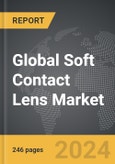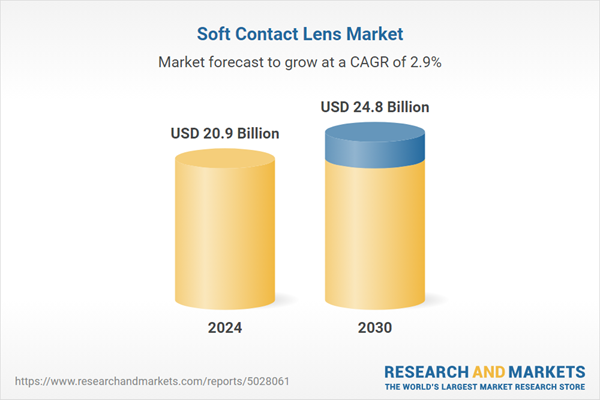The global market for Soft Contact Lens was valued at US$20.9 Billion in 2024 and is projected to reach US$24.8 Billion by 2030, growing at a CAGR of 2.9% from 2024 to 2030. This comprehensive report provides an in-depth analysis of market trends, drivers, and forecasts, helping you make informed business decisions. The report includes the most recent global tariff developments and how they impact the Soft Contact Lens market.
Segments: Usage Type (Daily, Weekly, Monthly, Other Usage Types).
Geographic Regions/Countries: World; United States; Canada; Japan; China; Europe (France; Germany; Italy; United Kingdom; Spain; Russia; and Rest of Europe); Asia-Pacific (Australia; India; South Korea; and Rest of Asia-Pacific); Latin America (Argentina; Brazil; Mexico; and Rest of Latin America); Middle East (Iran; Israel; Saudi Arabia; United Arab Emirates; and Rest of Middle East); and Africa.
The analysts continuously track trade developments worldwide, drawing insights from leading global economists and over 200 industry and policy institutions, including think tanks, trade organizations, and national economic advisory bodies. This intelligence is integrated into forecasting models to provide timely, data-driven analysis of emerging risks and opportunities.
Global Soft Contact Lens Market - Key Trends and Drivers Summarized
Why Are Soft Contact Lenses the Preferred Choice for Vision Correction?
Soft contact lenses have become the preferred choice for vision correction due to their comfort, flexibility, and convenience. Made from hydrophilic materials such as silicone hydrogel, soft contact lenses allow oxygen to pass through to the cornea, providing greater comfort for extended wear compared to rigid gas-permeable lenses. These lenses are used to correct common refractive errors, including myopia (nearsightedness), hyperopia (farsightedness), astigmatism, and presbyopia, offering a wide range of options for various visual needs. The increasing prevalence of vision impairment and eye disorders worldwide, coupled with rising awareness about eye health and vision correction solutions, is driving the demand for soft contact lenses. Moreover, the growing adoption of daily disposable lenses, which offer convenience and reduced risk of infection, is further propelling the soft contact lens market.How Are Technological Advancements and Consumer Preferences Influencing the Soft Contact Lens Market?
Technological advancements in lens materials, designs, and manufacturing processes are significantly enhancing the comfort, safety, and performance of soft contact lenses. Innovations such as silicone hydrogel lenses, which provide higher oxygen permeability, and toric lenses for astigmatism correction are expanding the market's appeal among consumers. The introduction of multifocal lenses that cater to presbyopic patients and daily disposable lenses that offer hygiene and convenience are driving market growth. Additionally, the development of smart contact lenses with integrated sensors for health monitoring and augmented reality applications is opening new frontiers in the industry. Consumer preferences are also shifting towards lenses that offer UV protection, blue light filtering, and personalized designs, further influencing market dynamics. The increasing availability of soft contact lenses through online sales channels and e-commerce platforms is enhancing market accessibility and driving adoption across different demographics.Which Market Segments Are Contributing to the Growth of the Soft Contact Lens Industry?
Product types include daily disposable lenses, weekly disposable lenses, monthly disposable lenses, and extended-wear lenses, with daily disposable lenses holding the largest market share due to their convenience and safety benefits. Lens designs are categorized into spherical, toric, multifocal, and cosmetic lenses, with spherical lenses being the most widely used for correcting common refractive errors. Distribution channels include optical stores, hospitals and clinics, online platforms, and others, with online platforms witnessing rapid growth due to the increasing shift towards e-commerce and direct-to-consumer sales. Geographically, North America and Europe dominate the soft contact lens market due to high awareness of eye health, advanced healthcare infrastructure, and the presence of key market players, while Asia-Pacific is expected to experience significant growth due to rising disposable incomes and increasing adoption of vision correction solutions.What Are the Key Drivers of Growth in the Soft Contact Lens Market?
The growth in the soft contact lens market is driven by several factors, including the increasing prevalence of vision impairment, technological advancements in lens materials and designs, and the rising demand for convenience and comfort in vision correction solutions. The shift towards daily disposable and specialty lenses, such as multifocal and toric lenses, is driving demand across various age groups and demographics. Technological innovations, such as smart contact lenses with health monitoring capabilities and lenses designed for blue light protection, are expanding the application scope of soft contact lenses, supporting market growth. The expansion of online sales channels and the growing popularity of customized and cosmetic lenses are creating new opportunities for market players. Additionally, the increasing focus on eye health awareness campaigns, coupled with the rising adoption of vision correction solutions in emerging markets, is further supporting the growth of the soft contact lens market.Report Scope
The report analyzes the Soft Contact Lens market, presented in terms of units. The analysis covers the key segments and geographic regions outlined below.Segments: Usage Type (Daily, Weekly, Monthly, Other Usage Types).
Geographic Regions/Countries: World; United States; Canada; Japan; China; Europe (France; Germany; Italy; United Kingdom; Spain; Russia; and Rest of Europe); Asia-Pacific (Australia; India; South Korea; and Rest of Asia-Pacific); Latin America (Argentina; Brazil; Mexico; and Rest of Latin America); Middle East (Iran; Israel; Saudi Arabia; United Arab Emirates; and Rest of Middle East); and Africa.
Key Insights:
- Market Growth: Understand the significant growth trajectory of the Daily segment, which is expected to reach US$9.4 Billion by 2030 with a CAGR of a 3.4%. The Weekly segment is also set to grow at 3.0% CAGR over the analysis period.
- Regional Analysis: Gain insights into the U.S. market, valued at $5.6 Billion in 2024, and China, forecasted to grow at an impressive 5.0% CAGR to reach $4.9 Billion by 2030. Discover growth trends in other key regions, including Japan, Canada, Germany, and the Asia-Pacific.
Why You Should Buy This Report:
- Detailed Market Analysis: Access a thorough analysis of the Global Soft Contact Lens Market, covering all major geographic regions and market segments.
- Competitive Insights: Get an overview of the competitive landscape, including the market presence of major players across different geographies.
- Future Trends and Drivers: Understand the key trends and drivers shaping the future of the Global Soft Contact Lens Market.
- Actionable Insights: Benefit from actionable insights that can help you identify new revenue opportunities and make strategic business decisions.
Key Questions Answered:
- How is the Global Soft Contact Lens Market expected to evolve by 2030?
- What are the main drivers and restraints affecting the market?
- Which market segments will grow the most over the forecast period?
- How will market shares for different regions and segments change by 2030?
- Who are the leading players in the market, and what are their prospects?
Report Features:
- Comprehensive Market Data: Independent analysis of annual sales and market forecasts in US$ Million from 2024 to 2030.
- In-Depth Regional Analysis: Detailed insights into key markets, including the U.S., China, Japan, Canada, Europe, Asia-Pacific, Latin America, Middle East, and Africa.
- Company Profiles: Coverage of players such as Carl Zeiss AG, Contamac Ltd., CooperVision, Inc., Essilor International, Ginko International Co., Ltd. and more.
- Complimentary Updates: Receive free report updates for one year to keep you informed of the latest market developments.
Some of the 46 companies featured in this Soft Contact Lens market report include:
- Carl Zeiss AG
- Contamac Ltd.
- CooperVision, Inc.
- Essilor International
- Ginko International Co., Ltd.
- Hoya Corporation Eye Care Company
- Johnson & Johnson
- Menicon Co., Ltd.
- Novartis AG
- Sensimed AG
- SynergEyes, Inc.
- UltraVision CLPL
- Valeant Pharmaceuticals International, Inc.
Tariff Impact Analysis: Key Insights for 2025
Global tariff negotiations across 180+ countries are reshaping supply chains, costs, and competitiveness. This report reflects the latest developments as of April 2025 and incorporates forward-looking insights into the market outlook.The analysts continuously track trade developments worldwide, drawing insights from leading global economists and over 200 industry and policy institutions, including think tanks, trade organizations, and national economic advisory bodies. This intelligence is integrated into forecasting models to provide timely, data-driven analysis of emerging risks and opportunities.
What’s Included in This Edition:
- Tariff-adjusted market forecasts by region and segment
- Analysis of cost and supply chain implications by sourcing and trade exposure
- Strategic insights into geographic shifts
Buyers receive a free July 2025 update with:
- Finalized tariff impacts and new trade agreement effects
- Updated projections reflecting global sourcing and cost shifts
- Expanded country-specific coverage across the industry
Table of Contents
I. METHODOLOGYII. EXECUTIVE SUMMARY2. FOCUS ON SELECT PLAYERSIII. MARKET ANALYSISIV. COMPETITION
1. MARKET OVERVIEW
3. MARKET TRENDS & DRIVERS
4. GLOBAL MARKET PERSPECTIVE
UNITED STATES
CANADA
JAPAN
CHINA
EUROPE
FRANCE
GERMANY
ITALY
UNITED KINGDOM
SPAIN
RUSSIA
REST OF EUROPE
ASIA-PACIFIC
AUSTRALIA
INDIA
SOUTH KOREA
REST OF ASIA-PACIFIC
LATIN AMERICA
ARGENTINA
BRAZIL
MEXICO
REST OF LATIN AMERICA
MIDDLE EAST
IRAN
ISRAEL
SAUDI ARABIA
UNITED ARAB EMIRATES
REST OF MIDDLE EAST
AFRICA
Companies Mentioned (Partial List)
A selection of companies mentioned in this report includes, but is not limited to:
- Carl Zeiss AG
- Contamac Ltd.
- CooperVision, Inc.
- Essilor International
- Ginko International Co., Ltd.
- Hoya Corporation Eye Care Company
- Johnson & Johnson
- Menicon Co., Ltd.
- Novartis AG
- Sensimed AG
- SynergEyes, Inc.
- UltraVision CLPL
- Valeant Pharmaceuticals International, Inc.
Table Information
| Report Attribute | Details |
|---|---|
| No. of Pages | 246 |
| Published | April 2025 |
| Forecast Period | 2024 - 2030 |
| Estimated Market Value ( USD | $ 20.9 Billion |
| Forecasted Market Value ( USD | $ 24.8 Billion |
| Compound Annual Growth Rate | 2.9% |
| Regions Covered | Global |









